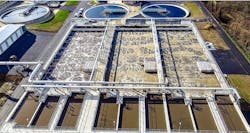The Client’s Needs
Following new regulations from the Ohio EPA and the Tuscarawas River Total Maximum Daily Load (TMDL) report, the City of Massillon WWTP was required to not only increase the plant flow capacity from 15.8 MGD to 17 MGD, but also achieve a total nitrogen limit of less than 10 mg/L and a TP limit of less than 1 mg/L. These requirements posed great challenges to the plant that was only achieving nitrification at the time and had very limited resources (both land and funding). Finding the right technology was key to the plant expansion and compliance goals.
The Solution
After evaluating multiple alternatives, the AnoxKaldnes Hybas™ IFAS system was considered to be the most technologically capable and cost effective solution to meet the Cities challenges.
The AnoxKaldnes Hybas™ system is a hybrid process that combines the AnoxKaldnes™ biofilm technology and activated sludge in the same tank. This technology facilitates the creation of additional biomass within the treatment process to meet more stringent effluent standards and increased flow and loading, without requiring or minimizing new tank construction..
The Benefits
- Increase plant capacity with low CAPEX
- Maximize biological TN and P removal
- Minimize new tank construction and save space
- Reduce chemical consumption
Process Description
Based on the influent/site conditions and treatment requirements, the AnoxKaldnes Hybas™ process design team turned the existing trickling filter/oxidation ditch process into an IFAS-A2O process (Figure below). To achieve and maximize biological phosphorus removal and denitrification, small anaerobic and pre-anoxic zones were constructed downstream of the primary clarifiers and upstream of the existing aeration tanks. The retrofitted system kept the plant’s three-train design. Each train consisted of an anaerobic zone, two pre-anoxic zones, followed by one IFAS zone and one deox zone. The influent design basis and the effluent objectives are shown in Table 1 below.
Results
The AnoxKaldnes Hybas™ system has been in continuous operation since 2018 and has enabled the plant to consistently meet their permit limits. A process performance evaluation was conducted during November and December of 2019. The effluent characteristics of the plant from the evaluation were as follows: sBOD5 ≤ 6.0 mg/L; NH3-N ≤ 0.2 mg/L; TN ≤ 8.6 mg/L; PO4-P ≤ 0.3 mg/L. Based on these results, the very first AnoxKaldnes Hybas™ system in Ohio has proven to be a viable solution for other plants facing similar challenges or with similar needs.
Editor's Note: Scranton Gillette Communications and the SGC Water Group are not liable for the accuracy, efficacy and validity of the claims made in this piece. The views expressed in this content do not reflect the position of the editorial teams of Water & Wastes Digest, Water Quality Products and Storm Water Solutions.

